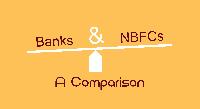
Banks and Non-Banking Financial Companies (NBFCs) are the two major types of financial intermediaries in any financial system. The NBFCs are often private owned entities and when the government owned entities are added, they are classified as NBFIs (Non-Banking Financial Intermediaries).
NBFCs are mostly private owned financial institutions regulated by the RBI and other government entities. Both of them perform exceptional role in their respective domains. A comparison between the two is always important from the angle of monetary policy as well as the interest of depositors and investors.
There are some differences as well as similarities regarding the functioning of the two. First is from the angle of functioning and second from the angle of the extent of financial regulation by the RBI on both.
Deposit acceptance
Firstly, banks can do almost all financial services and products generally authorized to them. They can accept demand deposits (demand deposits have high liquidity and is considered as good as money). NBFCs can’t accept demand deposits.
The NBFCs can provide only specifies functions devoted to them. There are few deposit (other type of deposits) accepting NBFCs, but they are very strictly regulated by the RBI. The NBFCs are allowed to accept/renew public deposits for a minimum period of 12 months and maximum period of 60 months. There are only 254 deposit taking NBFCs out of 12000 registered NBFCs. Regarding interest rate, the maximum rate of interest an NBFC can offer is 12.5%. The interest may be paid or compounded at rests not shorter than monthly rests. The repayment of deposits by NBFCs is not guaranteed by RBI.
Regulation
Second, from the angle of financial regulation, banks are strictly regulated by the RBI as they deal with public deposits. The NBFCs are also have to follow RBI’s strict regulations but the extent of control is less compared to the banks. But in recent times, there is regulatory convergence between banks and NBFCs. This means that the regulatory norms are now coming look alike for both (though with slight differences). Following are the main differences between banks and NBFCs.
| Area | Banks | NBFCs |
| Demand Deposits | Can accept all types of deposits | Can’t accept demand deposits |
| Deposit insurance | Covered under the RBI’s deposit insurance. | No deposit insurance |
| Payment and Settlement system of the RBI | Banks are supported by the Payment and Settlement System (RTGS, NEFT etc.,) | Can not avail the payment and settlement system. |
| Foreign investment | Allowed up to 74% | Allowed upto 100% |
| CRR | Applicable | Not applicable |
| CRAR | Applicable | 15% CRAR for Deposit seeking NBFCs and Non-Deposit seeking – Systemically Important NBFCs. |
| SLR | Applicable | 15% SLR for deposit taking NBFCs |
| SARFAESI | Applicable | Applicable |
| Provisioning | Applicable | Applicable |
| Incorporation | Banking Regulation Act | Companies Act (mostly) |
Why demand deposits acceptance is an important factor separating banks and NBFCs?
Demand deposit is a bank account which allows the account holder to withdraw his money from the account at his will and by any means without a notice to the bank. Demand deposits are unique because of two features: (i) liquidity and (ii) accessibility.
Liquidity
The demand deposits balances are like ready to use money of the account holders in banks. Hence, they are usually considered as money and form the greater part of the narrowly defined money supply of a country. In the definition of Narrow Money, the demand deposits come as a main component.
M1 = Currency with the Public + Demand Deposits with the Banking System + ‘Other’ Deposits with RBI
There are M0, M1, M2, M3 and M4. The degree of ‘moneyness’ decreases from M0 to M4. M0 is the reserve money which is constituted mainly by currency supply in the economy.
Here, from the monetary policy angle, demand deposit becomes very important. An institution that accepts demand deposits should be strictly controlled and regulated by the RBI. Hence, NBFCs which are nick named as shadow banks are not permitted to accept it.
Similarly, when commercial banks issue cheques, it will lead to multiplier effect on money supply. Such power is absent for NBFCs as they can’t issue cheques.
Accessibility
The demand deposits can be accessible through any form (ATM, direct banking etc.). Hence the banks have to discharge them as soon and on the spot. Here also the NBFCs as a financial intermediary has limitations.
*********









